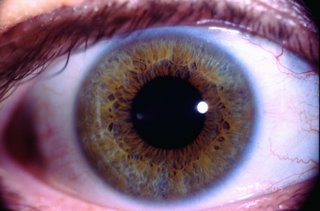Diagnosis: R/O Inflammatory Breast Cancer

Client presented to her doctor with symptoms involving her right breast and had undergone a series of tests to determine the cause. Her doctors were unable to agree on a definitive diagnosis but had a high 'index of suspicion' for inflammatory breast cancer.
Since the client was not a smoker, the strong blue tinge to the periphery of most of the iris suggests tissue hypoxia and a possible iron deficiency; but the probable cause for such a deficiency cannot be determined by the iris.
The sign of particular interest is what appears to be a chronic to degenerative lesion at 8:30 o'clock, ~.6R; which is not the 'classic' breast cancer sign observed by Dr. Jensen. A similar sign also occurs in the esophagus area at 3:06 o'clock, ~.6R, and in the lung area at 9:36 o'clock and .6R.
Months subsequent to this picture, it was provisionally determined that the client did not have inflammatory breast cancer; a conclusion which demonstrates both the power and the limitations of Iridology.
The existence of chronic to degenerative signs in both the breast area, the esophagus area and the lung area raises the question of whether the client's mother or father was a smoker who had suffered breast, lung and/or esophageal cancer prior to the client's conception. That is, some chronic to degenerative signs in the iris are a result of genetic inheritance and do not necessarily indicate significant problems with the client's physiology.
Thus, Iridology is a science in which 'false positives' tend to outnumber 'false negatives'.
In addition, organs removed under anesthesia retain the sign prior to their removal--an acute sign in the appendix or tonsils after an appendectomy or tonsillectomy, for example--because anesthesia disrupts the direct neurological connection between that organ and the iris.
According to Walter Lang, a German medical researcher, 'autonomic nerve fibers from every tissue in the body connect to the thalamus and hypothalamus; and, from there, through the opthalmic branch of the trigeminal ganglion to the motoneurons of the iris structure.'
("Iridology, the Science and Practice in the Healing Arts, Volumn II", Bernard Jensen, Copyright, 1982, pg. 84)

0 Comments:
Post a Comment
<< Home